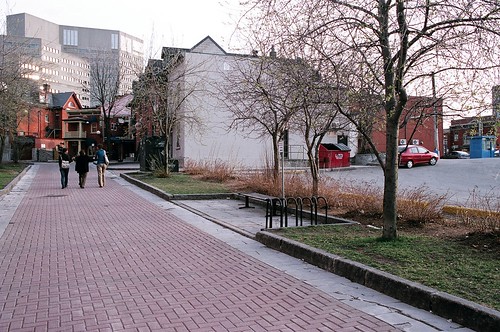
Ed: Thus continues the investigation into the many parking lots of downtown Hull by Spacing’s Ottawa/Gatineau Region correspondent Amber Yared:
Three Impervious P-lot personnel congregated for a second interview, this time in Hull with Historian Consultant Michelle Guitard.
We sought out Guitard to find out exactly what used to be where the parking lots are now. As we had suspected, buildings had been there; but it was more lucrative for property owners to tear them down and build parking lots or to lease the land to parking lot entrepreneurs than to maintain the old buildings. Guitard walked us through the streets and pointed to the ghosts of homes, restaurants, cinemas, and hotels. The block of parking pictured below used to be a funeral parlour, several houses, and a hall that was the first theatre and radio station in Hull.
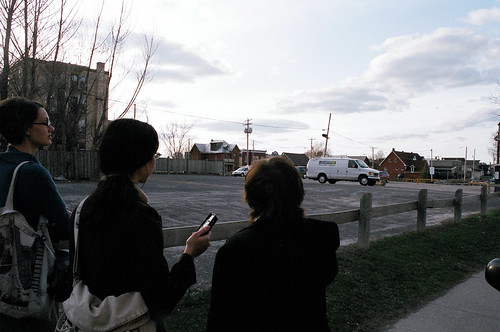
Guitard informed us that the grey and brown federal complexes, built in the 1970s, had contributed to the growth of parking lots and the destruction of a French professional and working-class community:
“So the 1970 architectural concept of government buildings … First of all it’s grey, as you see. And when it’s not grey, it’s brown. The idea was to be able to go from one building to another without ever going on the street, so they destroyed the street. I want to show you this.
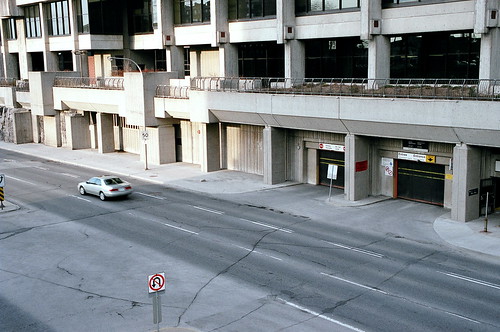
“This used to be restaurants, bookstores, pharmacies, different stores. So this whole street was very busy. City hall was over here, shops, restaurants, offices, doctors’ offices, lawyers’ offices with people living on top. What you see now is an indoor parking lot. They have destroyed the street completely. It looks almost as if it was a fortification without any outside walls. It’s not only parking on the streets that has destroyed the city; but also the parking underground that makes walls on the street.â€
The more Guitard told us, the more I was shocked. I had imagined that beautiful old houses had been demolished to be replaced by p-lots, but I was completely overwhelmed by the contrast between the society Guitard described and what I saw before me now. The parking lots and many of the dead, unused spaces surrounding them were once alive with buildings and people. How could this have happened?
MG: When I see this, like it is now, it is unbelievable because everybody from the streets around would walk up and down to see if they would meet anybody. It was full of people. Across the street where there is this ugly building, there was a very nice cinema. One there and one there. …There you have another beautiful spot of parking lots! Again, along here where these parking lots are now, there were houses.
AY: So what was the reaction? Did people fight it?
MG: Very much… when it started… when they started to make the plans to construct the government buildings. They destroyed complete neighbourhoods; so naturally they contested. Many of the owners of shops thought that it would bring them money—that the people working for the government would come here and work here. But that’s not what happened. They were so afraid of anything going on in Hull that they would go to Ottawa with their money. Many of the banks closed and the shops went completely pffft! Many of the citizens that used to buy didn’t buy. Most people who used to live here moved to Aylmer or Gatineau and they started shopping there. They didn’t come back on the main street to buy. So there was a complete degradation of the heart of the city and of the social relationships between people because they were spread everywhere else. The population of the island of Hull went from 22,000 to 9,000 — of people living, not people working, but living.
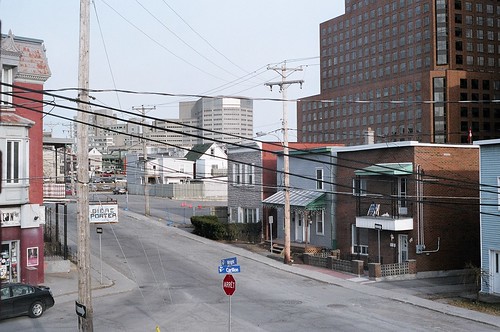
Which brings us to the obvious reason why Hull has as many parking lots as it does; thousands of people who are not residents of Hull work in the massive brown and grey government buildings, and probably the majority of them bring their cars with them.
Amber Yared is one among a group of artists, writers, educators, and architects working on The Impervious P-lot, a Hull-based CUP project about parking lots and what they do besides store cars. She will be posting her findings on the Spacing Wire as the project progresses.

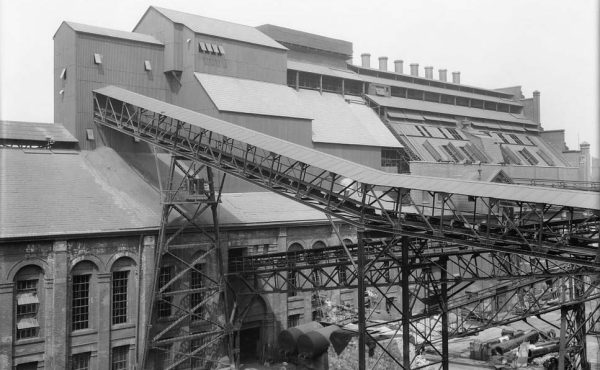


14 comments
Weird. I used to live on Wright, a couple blocks the other way from that photo up there, and work in that big brown building.
A lot else was going on in Hull, too. The Eddy Company and the rest of the paper industry, which employed a lot of those people and was the major industry in town was drying up and is, by now, pretty much dead. The tax differential between Ontario and Quebec made it an expensive choice to live in the Quebec side, and the better hospitals and schools on the Ottawa side didn’t hurt: remember that these photos, and downtown Hull, are about 30 seconds away from the bridge. Car culture wise, downtown Hull has got nothing on the rest of the now-merged Gatineau, which is basically endless suburbs. And, revenue-wise, things got bad enough with the nightclub strip that they harmonised closing times and basically took away a lot of that cross-bridge traffic.
Here is a clear example of what cars do to cities and the terrible consequences of planning and architecture in the 60’s-70’s. This should be a warning for all those shopkeepers along King, Queen, College, Bloor et al, that the car and massive parking lots do not bring them more business; it can actually kill them. Pedestrians and vibrant neighbourhoods are what keep them alive.
Carlos> These could just be bad buildings, nothing to do with the 60s and 70s — loads of buildings from that era work just fine, and people like them.
Shawn> It is a matter of taste. To me those buildings are by far the ugliest ever made. There are many of good design (such as our own city hall), but in my view (which is not a professional one) post war architecture and urban planning with these brown and grey monsters and the creation of suburbia was probably the worst thing that ever happened to cities across the globe (maybe excluding the mass bombardments in European cities during WWII). Sorry, it is just the way I see things, I hate that architecture, I hate it so much that I prefer baroque architecture a lot more than this monolithic sterile architecture from the 70’s. It is just my opinion, nothing else…
I guess that’s my point, it’s taste. The buildings in the pics above are terrible beasts yes, but we (“they”) build beasts today, and they did in the past (maybe more of them have been torn down by now though, so it seems like there are less). Some of my favorite buildings are from this era, and they make me feel the happiest.safest.civic.minded.etc.
In October Coach House and ERA Architects are releasing Concrete Toronto — a celebration of some of our great buildings from the post war era that I hope will help spread the appreciation of the good buildings.
Hate to say it, but even the 70s Hull complexes might, in a “Concrete Toronto” spirit, merit a second look–as urbanistically disastrous as they may have been relative to the existing fabric of Hull, they’re really not bad for “bad buildings”, formally speaking. There’s a certain state-of-the art spirit-of-the-Trudeau-age megastructural grandeur there–and rather benign now that we know they’ll *never* be building anything like that, again. Big bad Brutalism for bureaucrats, gone bittersweet. (If one can admire Robarts, why not the Hull complexes?)
In another context, I’ve defended Ryerson’s “70s Brutalist monstrosity” Jorgenson Hall for its “polytechness”, i.e. if you can grok vintage Pink Floyd or Soft Machine, you can grok this kind of architecture. (Maybe, then it’s the architectural-appreciation equivalent of Wyatting…
http://www.guardian.co.uk/g2/story/0,,1816709,00.html )
I think it’s important to consider the physical context too. The brown and grey buildings are massive and loom over the tiny two-storey houses and commercial buildings in the surrounding neighbourhood. The complexes are so out of place that I have a weird experience when I look at them; the brown one in particular appears as a heavy, brown mirage — so big that it is beyond comprehension. No neighbourhood could sustain offices of such high density. This is a unique situation — especially when compared to the car-culture and parking lots of suburbia.
It’s not just a question of taste. It’s also about safety, sunshine, community, consideration for what and who was there before. Why were these buildings placed in Hull? Were the intentions good? Was the federal government trying to give something to Hull? Or was it an attempt to build a wall between Hull and Ottawa? To hide Hull from view of Ottawa?
Adam, I find it really hard to separate the aesthetics or style of the architecture from their physical context.
To me, the concrete turkey is a different story because it’s part of a continuum of larger buildings. I wonder what it would be like to instead have Robarts plunk in the middle of a residential neighbourhood.
I also don’t think it’s about architectural taste. The grey and brown buildings may look okay in a photo, or even in real life if you have an open mind (though I do have my suspicions about making such structures sites of nostalgia for modernist brutalism and for masterplanning),but as a pedestrian they present certain problems. They are giant walls. Wide streets accompany them as do unsafe (for pedestrians) intersections and unsafe underground parking entries. No loitering signs too. Nobody is around them after 5 pm. You have to pass through them to get from Ottawa into what is left of Hull. Not a good thought went into them when it came to integrating them into an existing place. If pedestrians are considered the basic unit of city planning, as I think planners should be thinking, then the issue is way beyond aesthetics. They are there, so it is of course forward-thinking to imagine improving them. I don’t think we need to be content with the way they look.
“I wonder what it would be like to instead have Robarts plunk in the middle of a residential neighbourhood.”
Look north and west. Robarts *was*, in effect and in part, plunked in the middle of a residential neighbourhood.
==============
“I don’t think we need to be content with the way they look.”
No, but we can be open-minded and subversively creative about the way these faits accompli work, or “don’t” work, or “can” work…
When I was reading the article, I was struck by how much Sudbury is a parallel for this situation (minus the government buildings). There are nearly more demolished-buildings-turned-parking-lot in the downtown than there are original buildings left standing. A walk through downtown is like a ghost walk, similar to Hull: this is where the Odeon Theatre was, and this was the huge post office with the giant clock tower, and here the popular Nickle Range Hotel once stood, and here the Borgia Street market… There are big empty gaps everywhere, like a child with missing teeth. And those parking lots are rarely full of cars it seems. Surely Sudbury and Hull are not the only ones with this history? One way we are and have tackled the issue in Sudbury (though it’s unfortunately too late for the bulk of the architectural history) is initiating a way of designating “historical” buildings. It’s not very much talked about though. There isn’t much of a force pushing that forward. How else do you counter-act this?
Mariana,
You say that Sudbury is initiating designation of “historical” buildings, presumably using council’s power under the Ontario Heritage Act to protect designated buildings from demolition. What do you mean when you say that it is not very much talked about?
Aside from designating heritage buildings, Sudbury could be developing policies to promote infill development and incorporating urban design guidelines to help fill in some of the parking lots downtown with sympathetic new buildings–all as part of its Official Plan review process. It’s just a question of whether these are perceived to be planning priorities or not by council.
So that’s what happened to downtown Hull. I’ve been wondering for years. Place du Portage is indeed an unwalkable obstacle of anti-human scale.
The Lebreton Flats neighbourhood just across the river is Ottawa’s own mega-project casualty, though there it’s even more senseless because, after all of the expropriation and demolition, nothing was built (until only a few years ago, when the new War Museum went in, which is appropriate, now that I think of it).
Funny you should mention the LeBreton Flats – the National Capital Commission was responsible for both megaproject casualties.